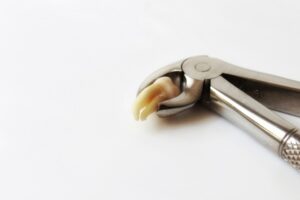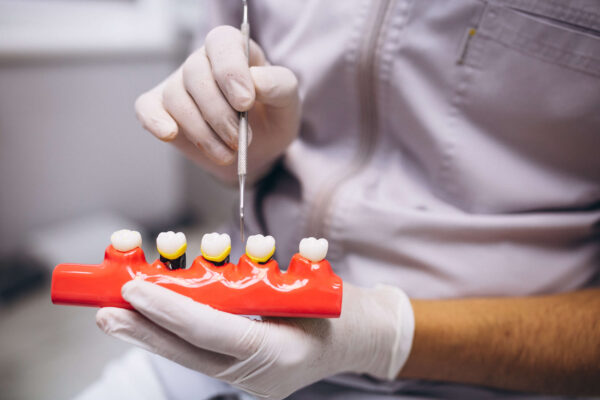The most common oral surgery is tooth extraction. More than 5 million people in the United States have their wisdom teeth extracted each year. Many other people have their teeth extracted due to crowding, infections, or tooth decay.
If you recently had a tooth extracted, you may notice a white formation in your tooth socket. This white material is usually granulation tissue, a fragile tissue composed of blood vessels, collagen, and white blood cells. Granulation tissue is a normal part of your body’s healing process and is not cause for concern. If you’re also in a lot of pain, the white material in your tooth could be a sign of an infection or a dry socket.
When you have a tooth pulled, you will often see white stuff form in your tooth socket. Most of the time, it means that the site is healing properly. The white stuff can be one of two things.
Typically, the white stuff is granulation tissue. It is essential to the healing process of the extraction site. Other times, the white stuff is pus or a dry socket.
A dry socket is often painful, and it occurs when the blood clot does not form correctly. If it is left untreated, a dry socket can trigger an infection. Read below to find out more about tooth extraction healing and what is the white stuff?
What is the White Stuff After Tooth Extraction?
Whether you get a tooth extraction due to having your wisdom teeth removed or an extraction because you have some damaged teeth, there is always a healing process involved. You may see the presence of white stuff in the tooth extraction area.
The white stuff can be one of two things. The first is a good, healing sign, and the second is not a good sign, but do not panic. Below will explain to you what the white stuff is in the tooth extraction site:
white stuff is in the tooth extraction site:
Healing Granulation Tissue
The healing process begins within the first day or so after tooth extraction. A blood clot develops over the extraction site. Shortly after, you will see tooth extraction healing white stuff form around the tooth socket.
If you are not in any pain, this is a good sign. It means that the white stuff is something called granulation tissue, that replaces the clot in the extraction site as the wound begins to heal. It plays an integral part in healing the area of the extraction site.
The granulation tissue is comprised of the following:
- Blood vessels
- Collagen
- White blood cells
Required Action:
Granulation tissue is a healthy aspect of healing in a tooth extraction site. If you just had your wisdom teeth removed, it is essential to keep the area clean so that the white stuff you see is not from any harmful bacteria, and it remains a good sign.
Surgical material
The dentist will apply gauze to the surgery site to stop the bleeding after the tooth is extracted. A small piece of gauze can be pushed into the socket, leaving a tiny cotton piece behind that may cause anxiety.
Required Action:
If the stuck gauze isn’t causing you any discomfort or pain, leave it alone. Your body will eliminate it on its own.
Stuck food particles
That white stuff in your empty tooth socket could be the last food you ate before the extraction. The food debris itself is not harmful, but it does pose a risk of dislocating the blood clot while the socket heals.
Required Action:
You can gently rinse your mouth with warm salt water 24 hours after your tooth extraction procedure to remove any food debris. Take ½ teaspoon salt and mix it with a few ounces of water.
Dry socket
A dry socket is the most common complication that can occur while your mouth heals from tooth extraction. According to a reliable source, 1-5% of people who have their teeth extracted develop dry sockets. It happens when the blood clot over the empty socket fails to form completely or becomes dislodged before the gum has fully recovered. A dry socket causes the bone and nerves to open, causing excruciating pain and discomfort.
Some other symptoms of dry socket include:
- pain traveling from the surgery area to your ear, or eye
- dislodged blood clot
- bad breath
- foul taste in your mouth
What does a dry socket look like
After tooth extraction, you should develop a blood clot in the socket (hole) that’s left behind. It’ll look like a dark-colored scab. But if you have a dry socket, the clot will be absent and you’ll be able to see bone. For this reason, dry sockets usually appear white.
Required Action:
If you suspect a dry socket, see your dentist or oral surgeon right away. Excruciating toothache several days after extraction is the most common dry socket symptom.
Oral infection
A person may occasionally notice a white-yellowish fluid at the healing site. Infection is indicated by pus. If the white pus is accompanied by these symptoms, the extraction site has become infected.
- Gum inflammation for the first 2-3 days
- more than 24 hours of continuous bleeding
- pain that gets worse
- foul taste in the mouth
- fever
Required Action:
If an infection develops at the surgery site, see your dentist right away. Your dentist or oral surgeon can determine the presence of an infection and prescribe appropriate treatment.
When the White Stuff is NOT a Good Sign
If your dentist needs to make an incision in the gum tissue to remove your wisdom teeth, you will need to be even more careful around the extraction site. The dentist may remove bone and teeth, which can trigger other problems.
There could be contamination in the normal socket after tooth extraction because of food that gets stuck, or it could lead to a painful dry socket. Your task is to make sure that the site is healing normally.
If you experience any of the following, there could be a problem within the extraction site:
- Discernible bone in the socket
- White pus in the tooth extraction site
- Pain following the procedure
- Pain that spreads from the ear, eye, temple, or neck
- Intolerable or bad taste in the mouth
- Inflammation
- Bad breath
- Partial or total loss of blood clot
If you encounter any of these signs above, it may indicate that the site is not healing correctly. A dry socket is the most frequent problem after getting a tooth extracted. The white stuff is the necrotic gum tissue surrounding the socket.
If the white stuff falls out of the socket, this is not a good sign. Your bones and nerves are not protected, which can leave you susceptible to infection.
If you believe you have got a dry socket, you should contact your Dentist Medford MA immediately.
What Are the Signs of Infection?
You may see white or yellow pus form after extraction. Pus indicates that there is an infection. Other signs of infection include:
- Persistent swelling
- Increased pain
- Fever
- Unpleasant taste in the mouth
- Bleeding that goes on for more than 24 hours
Infections are prevalent following a tooth extraction. The most evident sign of infection is bleeding, which typically occurs within two or three days after the procedure. You have to see your dentist as soon as possible.
Your family dentist will be able to stop the bleeding and give you antibiotics. Healing from a tooth extraction can be a complicated and often grueling process.
Healing generally takes about two weeks after the extraction. You will most likely have a follow-up appointment with your dentist medford after two weeks to determine your progression or success with the healing process.
What Healing After a Tooth Extraction Look Like
Tooth extraction is performed for a variety of reasons, including decay, infection, and overcrowding. According to Dental Experts, it is the most common oral surgical operation. An extraction, like any other operation, might put the patient at risk for infection or other postoperative consequences. Following extraction, patients should inspect the surgical site for any potential complications. However, knowing what normal healing looks like is also crucial so that the patient can distinguish between what is normal and what is pathological.
Normal signs of Tooth Extraction Healing
Around 72 hours following tooth extraction, the gum tissue around the extraction site begins to seal up. However, even before that, the patient can begin to notice symptoms of healing.
Blood clot
Clotting at the extraction site begins within the first 24 hours of the surgery. It looks like a dark-colored scab. Patients should keep an eye on the area to ensure that the blood clot forms properly. Nothing, however, should be done to dislodge the blood clot. It can create a painful condition termed as dry socket if it becomes dislodged.
Granulation tissue
The transition of the blood clot into granulation tissue is the next phase in the healing process. This is made up of blood vessels, white blood cells, and collagen, which aid in the fight against infection and fill in the gap left by tooth extraction. Granulation tissue can be white or cream in color. Granulation begins as soon as the blood clot is complete and can take up to seven days to finish.
Abnormal symptoms of Tooth Extraction complications
Normal signals of recovery can appear similar to aberrant symptoms to the untrained eye. Any worrisome symptoms that are accompanied by severe discomfort should be checked by an oral surgeon as soon as feasible.
Pus
Pus is an indication of infection. It appears as a thick yellow or white liquid. A terrible taste in the patient’s mouth, continuing bleeding or swelling, increased discomfort, and fever may also accompany it. After testing confirms the presence of the infection, the surgeon can prescribe medications to combat it.
Missing blood clot
Sometimes a blood clot does not develop or is dislodged before it has an opportunity to change into granulation tissue. This can result in a painful tooth extraction complication known as dry socket. Severe discomfort radiating from the extraction site to other regions of the face, such as the temple, eye, or ear, may warn the patient of the presence of dry socket before the missing blood clot is identified. However, the patient may also observe a whitish color at the extraction site from exposed bones and nerves, as well as dryness or emptiness of the socket.
What Should a Tooth Extraction Look like when Healing Pictures
When a tooth is extracted, a wound is created within the gums and alveolar bone. Inadequate care can result in significant and painful complications. Knowing how to take the essential precautions before and after the extraction surgery will make the healing process go more smoothly.

Conclusion
The white stuff that comes after a tooth extraction is often one of two things. Most of the time, it is granulation tissue, which is a typical sign of healing. Other times, it could signify an infection or a dry socket. If your extraction is not healing correctly or if you notice anything unusual, you need to visit the dentist. Medford Dentist will help you maintain healthy teeth. GIO Dental offers a full array of dental services to help you and your family maintain healthy teeth and is a trusted & reliable dentist in Medford, MA. To learn more about our dental services, call (781) 777-1812 or make an appointment with us today.

